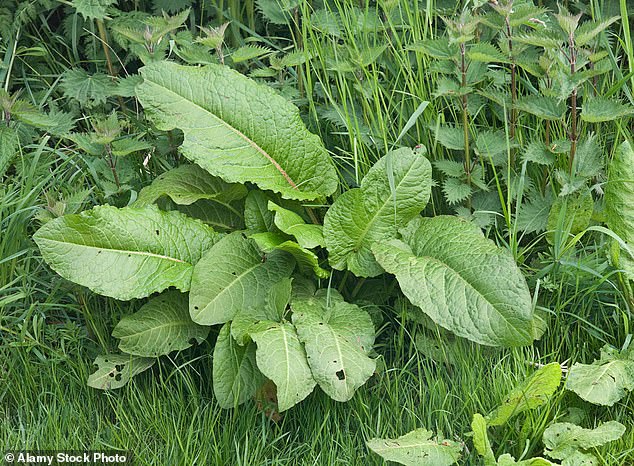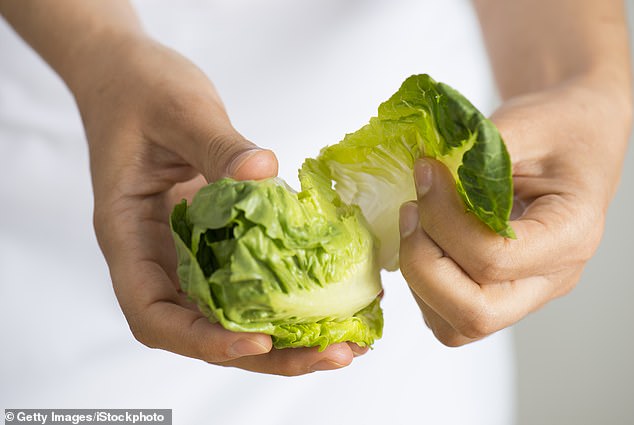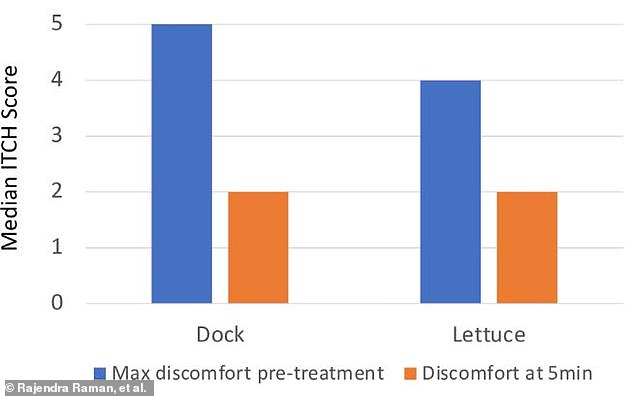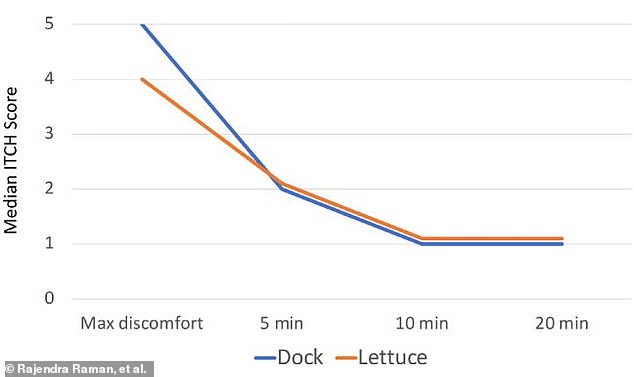I can’t be-leave it! LETTUCE is just as good as dock leaves for easing nettle stings, scientists say
When it comes to the nasty burning pain of nettle, nothing seems to soothe the pain like a clove leaf.
However, scientists say you might as well spread your salad on the sting.
Research published today in the Journal for emergency care found that sweet lettuce leaves were just as effective in reducing the discomfort of nettle stings.
In one study, two-thirds of participants could not tell the difference between a treatment with a sorrel leaf and a treatment with a small amount of lettuce.
Dr Rajendra Raman, a specialist in emergency medicine at the Victoria Hospital in Kirkcaldy, told MailOnline: ‘If someone wants to rub a leaf on them and there’s no sorrel, then lettuce is a reasonable choice because it’s completely non-toxic.’
If you get stung by a nettle, scientists now say that using a lettuce leaf could work just as well as a sorrel leaf to reduce the pain
The characteristic burning itch that nettles cause is caused by the hundreds of microscopic needles, called trichomes, that cover the plant.
When you stroke these needles, they burst and release a jet of chemicals including histamine, acetylcholine and serotonin.
Traditionally, it is said that the resulting rash and burning sensation can be relieved by rubbing a sorrel leaf, also known by its scientific name rumex obtusifolius, over the affected area.
As the researchers point out, this idea goes back at least 600 years, first appearing in the works of Geoffrey Chaucer, sometimes called the father of English literature.
If you search online, you will find all sorts of theories about how the leaves work. For example, they neutralize the acid in the nettle sting and contain natural antihistamines.
However, the researchers believe that it is simply the cooling sensation of the drying plant sap on the skin that causes the observed healing effect.

The researchers say that it is only the cooling of the plant sap that reduces the pain and that any large leaf would work, since the leaves of the sorrel (pictured) often grow near nettles, they have become a traditional medicine.
If so, then there is nothing special about the sorrel leaf and a lettuce leaf should do the job just as well.
The findings suggest that if you go for a walk in the woods this summer, you may want to take your lettuce with you in case you get stingers.
In the paper, Dr. Raman and his colleagues write: ‘Any large, fresh, non-toxic leaf would be suitable. Sorrel may have become the leaf of choice because it grows in similar habitats to nettle.’
To test the potential healing properties of sorrel leaves, the researchers set up a small-scale study involving nine healthy emergency room physicians.
Each participant was asked to rub a freshly picked nettle over a marked area on each forearm ten times, after which they were blindfolded.
To ensure there was no bias in treatment perception, each participant rolled a die while blindfolded to determine how the plants would be administered.
If an odd number was thrown, two sorrel leaves were rubbed on the right arm for 60 seconds and two lettuce leaves on the left arm for 60 seconds.
If an even number was thrown, the application was reversed: sorrel leaves on the left arm and lettuce on the right arm.

Researchers treated participants’ nettle stings with either a sorrel leaf or a sweet lettuce leaf. Two-thirds of participants could not tell the difference between the two treatments (stock image)
After administration, participants were asked which arm they thought had been treated with sorrel leaves and which with lettuce.
They were asked to rate their discomfort on a scale of one to five.
The score was kept until the symptoms disappeared. The researchers called this score the ‘Insult to Complete Healing’ score, or ‘ITCH’ score.
The researchers also recorded the number of visible ‘bumps’ – the reddish bumps caused by nettles – that were visible on the forearm.
This measurement was aptly named Observable Urticaria/Count of Hives score, or ‘OUCH’ for short.
Although Dr. Raman is keen to stress that this study was primarily intended as a light-hearted team-building exercise for the research group, the results suggest that sorrel leaves are of little benefit.
Three participants correctly indicated which arm had been treated with dock, three indicated incorrectly, and three could not indicate at all which treatment had been applied.

The researchers found that there was virtually no significant difference in discomfort (measured as the ITCH score) whether the person was treated with a sorrel leaf or a lettuce leaf
Although the participants’ ITCH scores decreased over time, the drug they were treated with did not make a statistically significant difference. Sorrel leaves only beat lettuce by one point.
Also, the participants had virtually identical OUCH scores regardless of whether they were treated with lettuce or sorrel.
“It’s possible that the rubbing itself, or perhaps the cooling effect of the sap evaporating from a bruised leaf, may also help relieve the pain,” Dr. Raman said.
Although the researchers in this study did not include a control group without treatment, Dr. Raman suggests that using either leaf likely does not affect how long the discomfort lasts.
Dr Raman says: ‘I cannot recommend rubbing nettle stings with anything as there is no scientific evidence that it helps.

The researchers suggest that pain would likely have decreased over time regardless of whether a blade was used, but that the placebo effect may still make people feel better after being stung.
‘It is more likely that the discomfort will decrease whether you rub it with sorrel or lettuce.’
But if you happen to be stung by a nettle, that solution might not be such a satisfying answer.
In their article, the researchers note that children in particular “may not find doing nothing an acceptable option when they are in pain.”
While Dr. Raman says that “gentle reassurance and time” is likely the only treatment for a child with nettle stings, that doesn’t mean using a sorrel or lettuce leaf is necessarily a bad idea.
Whether you use sorrel leaves or lettuce to treat stings, it’s likely that the placebo effect is at least partly responsible for making you feel better.
Considering how powerful the placebo effect can be, it’s possible that the lack of any real medicinal properties isn’t stopping this age-old remedy from working. In fact, it could provide some much-needed comfort.
Finally, Dr. Raman says, “Rubbing dock on nettle stings is a favorite childhood folk remedy for many people, and it is a fairly harmless activity.
“So I wouldn’t recommend rubbing the dock, but I wouldn’t actively discourage it either.”
